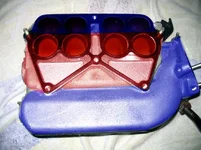- :
- Protege5 2003
peepsalot said:Correct.
The VTCS butterflies are at the edge of the manifold where it meets the head.
The VICS are inside the manifold which has to be taken apart into it's two halves to get to.
Ok, that's settled then.
As I understand it the VICS are normally closed and only open above a certain RPM in order to provide more air (or better intake tuning, or something like that.)
The VTCS on the other hand are open pretty much all the time except when the motor is cold when they change angle to cause turbulence in the flow which somehow or other results in the engine running cleaner, resulting in the ULEV designation. (Do the VTCS valves ever close all the way?) When the motor is warmed up the VTCS valves open as much as possible. So removing the VTCS, which it seems a lot of people have done, gives a little more power most of the time at the expense of increased emissions from the few minutes when the engine is really cold. The thing that strikes me as odd is that at the same time the car is playing with the VTCS valves it's also making the fuel mixture richer, apparently to heat up the catalytic converter faster. (I don't recall where I read that.) My car warms up pretty quickly, it only takes a minute or two for the T gauge to get near the middle of the range. Does anybody know exactly how much of a difference the presence of the VTCS actually makes in the emissions? Just to play devil's advocate, are the emissions when the car is warm lower, higher, or the same plus/minus the VTCS? Because it seems if the flow is a little better without the VTCS the motor might run slightly cleaner, and if emissions at normal temps were at all lower with the VTCS then the net emissions would depend on the ratio of run time warm vs cold.

